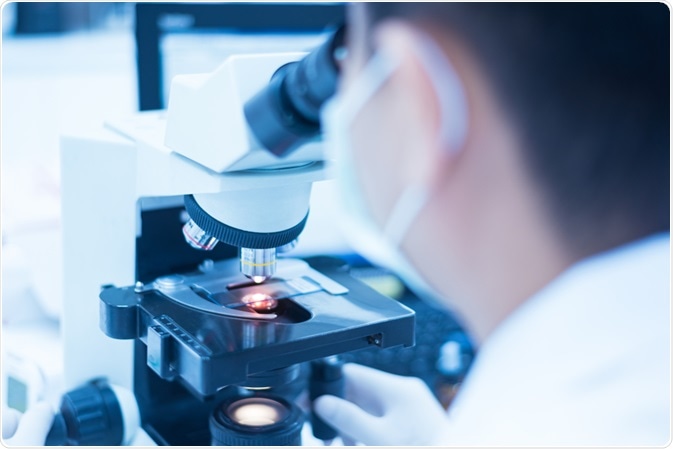The word microscope is derived from the Greek “mikros”, meaning small and, “skopein” meaning to see. A microscope is an instrument used for looking at objects that cannot be seen with the naked eye and microscopy is the science of using a microscope.

Microscope. Image Credit: Komsan Loonprom/Shutterstock.com
In simple terms, it is looking at small things and making them appear bigger so that we can study them. This simple idea has lead to a huge number of techniques and methods of observing small things.
The History of Microscopy
The origins of microscopy can be traced to around 1000 AD when a glass sphere was used to magnify text. In 1021 Iqbal al Haytham wrote a book on “Optics” which increased the understanding of how light behaved but it wasn’t until 1590 that Hans and Zacharia Janssen placed lenses in a tube to create the forerunner of modern microscopes. In 1609, Galileo famously developed the compound microscope which was not named until 1625 by Giovanni Faber.
In 1874, Ernst Abbe developed a formula that allowed the maximum resolution of a microscope to be calculated. In 1931, Ruske and Knoll built the first Transmission Electron Microscope using an idea from Sziland. Throughout the 20th and early 21st Century, there have been continued innovations in all branches of microscopy.
The Nobel Prize has been awarded to microscopy work twice; In 1986 it was awarded jointly to Ruske for work on the electron microscope and Binig and Rohrer for work on scanning and tunneling microscopy. In 2014, the prize was awarded to Betzig, Hell, and Moernerfor the development of super fluorescent microscopy which allows for resolution down to two micrometers.
Optical Microscopy
There are several variations of optical microscopy, one of which is the Compound Microscope. This is the most well-known type of microscope and consists of a tube containing an eyepiece lens at one end, and one or more objective lenses at the other end with different strengths that can be interchanged dependent on what is being studied. There will also be a focussing mechanism and stage to mount the sample and a light source below the sample shining through it. Optical microscopy is usually limited to about 1000 times magnification.
Several variations on the optical microscope exist, with some variations having single or binocular eyepieces and different light sources, either light emitting or reflection. It is also possible to have camera attachments or even a digital microscope that displays the image on a computer screen. The traditional method is to shine a light source through the sample, meaning that sample preparation is critical.
Inverted Microscopy is where the light source is above the sample and the lenses are below it. This type of microscopy is particularly useful in biological research
Stereo microscopy involves a microscope that has two matched microscopes side by side so that each eye has an individual view of the sample. They are used for dissection, moving microscopic tools, and examing electronic components
Polarizing Microscopy incorporates a polarizing filter into the microscopes so that only a single wavelength of light is transmitted. This type of microscopy finds use in studying crystals and detecting asbestos fibers
Metallographic microscopy is used in forensics and diagnostic microscopy where a light that shines onto an opaque surface and is reflected back into the microscope for examination.
Reflecting Microscopes use convex and concave mirrors to magnify visible, infrared, and ultraviolet images.
This is not an exhaustive list of types of optical microscopy, there are interference techniques that measure the interference to the light as it passes through a sample along with other types.
In addition to different types of microscopes, different treatments can be applied to samples such as dye and fluorescent substances to enhance the image or to highlight certain components that need to be studied.
Non-Optical Microscopy
There are several non-optical types of microscopy such as:
Scanning Electron Microscopy where high-energy electrons are scanned across a sample and various emissions are emitted and recorded. This type of microscopy can magnify five to 500,000 times
Transmission electron microscopy where electrons pass through a thin sample and are recorded. This type of system can magnify up to 50,000,000 times. They can produce detailed three-dimensional images of a sample which allow the topography, structure, and composition of a sample to be examined. This type of microscopy has biological uses as well as industrial uses where they can be used to detect fractures or impurities in minute products such as microelectronics.
Transmission Electron Microscope equipment is similar to an optical microscope but uses high-energy electrons instead of light. They are used for study in life sciences, medicine, forensics, and metallurgy amongst many applications.
Scanning Probe Microscopy (SPM) can analyze from a nanoscale down to individual atoms. The instrument consists of a sharp tip (as small as one atom) on a cantilever which is moved across a surface to measure deflections. These deflections are recorded and used to produce an image by deflecting a laser off the top of the cantilever.
Deflection can be caused by a mechanical, electrostatic, magnetic, chemical bond, Vander Waals, or capillary forces. The probe can be in continuous contact with the surface or, if it is very soft, sometimes the probe will rapidly tap the surface continually.
Atomic Form SPM measures electrostatic forces and Magnetic Form Microscopes using Magnetic forces and Scanning Tunnelling Microscopes which measure the current between the probe and the cantilever.
Summary
Microscopy is a varied and valuable science that has many different forms and uses several different techniques. Whatever the object to be studied, there will be a type of microscopy that is suitable. Some techniques are very expensive, so the type of microscopy and sample preparation chosen for a particular project will always depend on the objectives and the budget available.
Microscopy is continually developing as science and modern manufacturing techniques allow for better and better equipment to be produced and higher image quality and greater magnification.
Further Reading
Last Updated: Mar 24, 2021